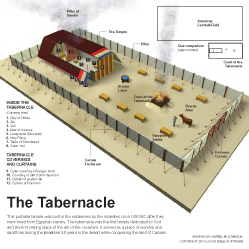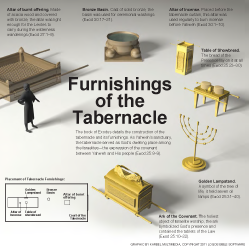26:1–37 This passage provides instructions for building the tabernacle itself—Israel’s approved house of worship until the temple was built under King Solomon. The tabernacle was dismantled and reassembled whenever the Israelites moved their camp. |
 Tabernacle Materials and Equipment Table
Tabernacle Materials and Equipment Table
26:1 tabernacle The Hebrew term used here, mishkan, refers to the Israelites’ portable sanctuary during their journey to the promised land (compare Exod 25:8–9; 35:30–36:38).
the work of a skilled craftsman The art of weaving using a loom goes back to Neolithic times and is still in use in areas of the world today. For most of history, this has been the work of children (since their hands are small), slaves, or the lower class. In the construction of the tabernacle, this is the work of skilled women (35:25–26).
26:3 joined They were to be connected to one another at the edge by a series of stitches—a series of loops and clasps, in this case.
26:4 loops of Loops were added to the edge of the curtains in order to hold the clasps that would connect the panels to one another. The row of loops and clasps would then be draped over the tent poles.
26:6 gold clasps Since these curtains separate the inner chamber from the outer chamber, the clasps are made of the most precious metal, gold, whereas the clasps for the outer curtains are bronze (v. 11).
one All ten of these curtains were to be attached to one another to form one large curtain. While this would help keep each individual panel in place, it would make the tent very difficult to move due it is sheer size and weight.
26:7 goat hair This hair was collected and spun into a type of wool, which was then woven into these eleven curtains (35:26).
26:9 you will fold double Meaning, use the extra panel to reinforce the opening of the tent, so that the chance of accidental entry, whether by human or animal, is minimized.
26:11 bronze clasps Since the previously described curtains (vv. 1–6) separate the inner chamber from the outer chamber, the clasps are made of the most precious metal, gold, whereas the clasps for these outer curtains are bronze (v. 11).
26:15 frames for the tabernacle of acacia wood as uprights It is unclear how the frames of the tabernacle were held together. The pieces had tenons and grooves (v. 17), but it is not clear whether they overlapped and were held by joints, fasteners, or clasps (see vv. 19–24).
were held together. The pieces had tenons and grooves (v. 17), but it is not clear whether they overlapped and were held by joints, fasteners, or clasps (see vv. 19–24).
26:17 two pegs This describes a protruding piece of wood that fits into a corresponding groove or slot, carved into whatever object the frame is designed to attach, in this case, another frame.
26:19 forty silver bases Probably both to hold the frames erect and to weigh them down.
silver The second most precious metal used in the tabernacle construction. See note on 25:3
26:22 the rear of the tabernacle on the west See note on 27:13.
26:29 you will overlay the frames with gold These frames would have been hidden from sight by the curtains of the tabernacle. The overlaying of gold was mostly done with careful hammer work (compare 37:17; 39:3), using thin sheets of gold that were produced by smelting and controlled pouring and cooling. A similar process was carried out in the construction of idols and other metal overlain objects throughout the ancient Near East.
26:30 according to its plan This plan or pattern was shown to Moses earlier (see 25:9).
mountain That is, Mount Sinai (24:15–25:1).
26:31–36 These verses describe the interior layout of the inner tent shrine of the tabernacle. The tabernacle included an outer structure (a curtained fence) and an internal structure, a fully enclosed tent partitioned into two rooms by a thick veil. The inner veil and the screen for the entrance of the tent are made of the same materials as the tabernacle curtains described in v. 1. The pillars for the veil and screen are also made of acacia wood just like the frames for the rest of the tabernacle (v. 15). The innermost section—the most holy place or holy of holies |
26:31 a curtain of This is the cloth that closes off the Holy of Holies (or Most Holy Place) from view.
(or Most Holy Place) from view.
26:33 the ark of The Hebrew word aron refers generally to a storage box, but it is commonly used to refer to the ark of the covenant. See note on 25:10.
See note on 25:10.
26:34 atonement cover The lid of the ark of the covenant. See note on 25:17.
of the ark of the covenant. See note on 25:17.
26:36 a screen of Describes the curtain that hung across the entrance of the tent, closing it off from the courtyard. Although it was embroidered, it apparently did not depict cherubim like the inner veil (compare v. 31).

|
About Faithlife Study BibleFaithlife Study Bible (FSB) is your guide to the ancient world of the Old and New Testaments, with study notes and articles that draw from a wide range of academic research. FSB helps you learn how to think about interpretation methods and issues so that you can gain a deeper understanding of the text. |
| Copyright |
Copyright 2012 Logos Bible Software. |
| Support Info | fsb |
 Loading…
Loading…


